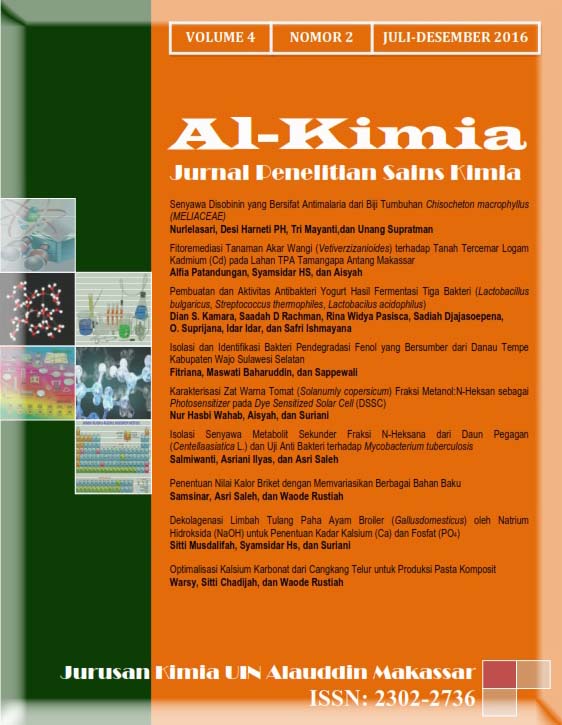Fitoremediasi Tanaman Akar Wangi (Vetiver zizanioides) Terhadap Tanah Tercemar Logam Kadmium (Cd) Pada Lahan TPA Tamangapa Antang Makassar
Abstract
One example of soil contamination on land landfill is (TPA) Makassar. The method of prevention is phytoremediation of the contaminated land. This study examined the ability of the plant will vetiver (Vetiver zizanioides) in reducing the levels of Cd in the soil. To increase the potential of these plants to remediate Cd, the soil where the plants grow is combined with compost in which bacteria within the compost might improve the absorption of Cd. Planting medium used is pure soil and compost from Tamangapa Makassar. Research carried out for 28 days with a variation of the study. The composition of the media that the contaminated soil (TT) metal kadmium (Cd) and compost (K) with a ratio of 100% (TT): 0 K, 5 (TT): 1 (K), 4.5 (TT): 1.5 (K) and 4 (TT): 2 (K). The results shwed that vetiver plants were able to absorb Cd of 0,298 mg/Kg so it can be concluded that the composition of the planting medium with a combination of compost less significant because the combination of the contaminated soil with compost are less precise in helping vetiver plants accumulate or reduce metal pollution cadmium in contaminated soil Tamangapa Antang Makassar.
Downloads
References
Bahtiar, Ayi, 2007, Polusi Air Tanah Akibat Limbah Industri dan Rumah Tangga Serta Pemecahannya, Bandung: Universitas Padjajaran.
Darmono, 1999, Kadmium (Cd) dalam Lingkungan dan Pengaruhnya Terhadap Kesehatan dan Produktivitas Ternak,Wartazoa, 8(1):28-32.
Fauziah, 2011, Efektivitas Penyerapan Logam Kromium (Cr) dan Kadmium (Cd) oleh Scenedesmus dimorphus, Jakarta: Universitas Islam Negeri Syarief Hidatullah.
Gunawan, G., Nanny Kusmaningrum, 2012, Penanganan Erosi Lereng Galian dan Timbunan Jalan dengan Rumput Vetiver, Bandung: Puslitbang jalan dan Jembatan.
Handayani, et. al., 2013, Efisiensi Fitoremediasi Pada AirTerkontaminasi Cu Menggunakan Salvina Molesta Mitchel, Kediri: Universitas Nusantara PGRI Kediri.
Irawanto, Rony, 2010, Fitoremediasi Lingkungan Dalam Taman Bali, UPT Balai Konservasi Tumbuhan Kebun Raya Purwodadi-LIPI, 2(4) : 29-35.
Khopkar, S., 2008, Konsep Dasar Kimia Analitik, Jakarta: UI-Press.
Raya, Indah, and Ramlah, 2012,The Bioaccumulation of Cd(II) ions on Euchemacottoni Seaweed Bioakumulasi Ion Cd(II) pada Rumput Laut Euchemacottoni, Makassar: Universitas Hasanuddin, 13(2): 3.
Rismawati, Senja Ike, 2012. Fitoremediasi Tanah Tercemar Logam Berat Zn Menggunakan Tanaman Jarak Pagar (Jatrophacurcas), Surabaya: Institut Teknologi Sepuluh November.
Triastuti, Yuli, 2010, Fitoremediasi Tanah Tercemar Merkuri (Hg2+) Menggunakan Tanaman Akar Wangi (Vetiver Zizanioides) Pada Lahan Eks-Tpa Keputih, Surabaya: Institut Teknologi Surabaya.
World Bank Group, 1998, Pollution Prevention and Abatement Handbook, Project Guidelines: Pollutants.
Widyawati, Enny, 2008, Peranan Mikroba Tanah pada Kegiatan Rehabilitasi Lahan Bekas Tambang (Roles of Soil Microbes in Ex-Mining Land Rehabilitation), Pusat Litbang Hutan dan Konservasi Alam, 5(2).
Yan, Wang, 2005, Phytoremediation Of Soil Contaminated With Copper And Zinc From Pig Waste, Malaysia: University Putri Malaysia.
Zubair, Achmad,dan Haeruddin, 2012, Studi Potensi Daur Ulang Sampah Di TPA Tamangapa Kota Makassar,Prosiding 2012 Group Teknik Sipil Universitas Hasanuddin, 6: 1-10.
Copyright (c) 2016 Al-Kimia

This work is licensed under a Creative Commons Attribution-NonCommercial-ShareAlike 4.0 International License.
Authors who publish with this journal agree to the following terms:
1) Authors retain copyright and grant the journal right of first publication with the work simultaneously licensed under a Creative Commons Attribution License that allows others to share the work with an acknowledgement of the work's authorship and initial publication in this journal.
2) Authors are able to enter into separate, additional contractual arrangements for the non-exclusive distribution of the journal's published version of the work (e.g., post it to an institutional repository or publish it in a book), with an acknowledgement of its initial publication in this journal.
3)Authors are permitted and encouraged to post their work online (e.g., in institutional repositories or on their website) prior to and during the submission process, as it can lead to productive exchanges, as well as earlier and greater citation of published work (See The Effect of Open Access).


